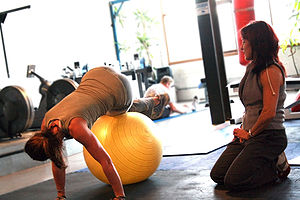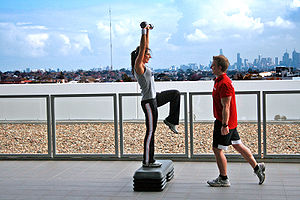
- Image by Carol Moshier via Flickr
Whether the goal is losing or maintaining a healthy weight, dancers are concerned about their silhouette and their nutrition.
A reader asks:
“I eat very well, everything’s healthy and not much candies, but I want to know your opinion. What is proper for a dancer? Any diet and nutrition that will help me both lose kilos or maintain my silhouette? I don’t mean an exhaustive diet, I just mean what to eat or not etc..
Losing Weight
If you take several dance classes per week and find you are still struggling to maintain an appropriate, healthy weight for your height and age, it is important to talk with your doctor or other health professional before taking steps to lose weight (see the Food and Nutrition Information Center for more on weight management).
While some swear that there are secrets to how or when you eat, in the end it still all comes down to mathematics. To lose, what you put in has to be less than what you burn. And to maintain, requires balanced nutrition. In either circumstance, an intake of quality nutrients is important, as is keeping an eye on portion size.
Different methods of change (I’m avoiding the word diet because to me this word does not imply lasting lifestyle change) work for different people – some find it best to completely avoid certain foods. Others prefer to replace the ingredients of foods they love with healthier alternatives. Sometimes a bit of trial and error is necessary to determine what works best for each individual. Also, don’t forget the mind and emotions can often play a big role in supporting or sabotaging one’s healthy intentions.
Simple Start
Often we don’t realize how much salt and sugar is in our food but cutting down can yield lasting results for health and weight-loss. For many this is a good place to start. (this article from Harvard School of Public Health covers the war on sugary drinks and processed foods)
More tips for cutting down on sugar… and on salt [pdf].
Cross-training for strength and endurance is also a good idea for any dancer. In particular, dancers who aren’t training heavily, keeping the heart rate up or working up a sweat for 20-minutes or longer during class or rehearsal multiple times per week, may need to add cross-training activities to their schedule.
Balanced Nutrition
- Image via Wikipedia
The guidelines for creating a healthy balance of nutrition are constantly under scrutiny by the medical field and new discoveries about the body may reveal new methods, suggestions, or recommendations. It can get pretty confusing.
It is well-recognized that humans would do well to lower their intake of “bad” fats (saturated fats mainly found in animal products and trans fats in pre-packaged foods) and increase, or exchange some of these for “good” fats like those that come from nuts, avocados, and fish. But even this can get confusing.
Some simple guidelines:
- In our pre-packaged fast-food world remember that fresh is always best!
- Enjoy many different kinds of foods!
- Cook more, eat out less!
What the Experts Say…
 Admittedly, I struggle as much as any dancer to strike that perfect balance and to stay on top of the latest health information. I have no formal expertise on the subject of nutrition. Therefore, I rely on what the experts say. For dancers, a great resource is the International Association for Dance Medicine & Science. They are the publishers of the Journal of Dance Medicine & Science and the associations members and directors are among the top in this field.
Admittedly, I struggle as much as any dancer to strike that perfect balance and to stay on top of the latest health information. I have no formal expertise on the subject of nutrition. Therefore, I rely on what the experts say. For dancers, a great resource is the International Association for Dance Medicine & Science. They are the publishers of the Journal of Dance Medicine & Science and the associations members and directors are among the top in this field.
Here are a few excerpts from their Nutrition Fact Sheet:
- The first step in planning a high performance diet* is to be sure that the dancer is obtaining adequate caloric intake. The easiest rough estimate of how many calories a dancer requires during heavy training is 45-50 calories per kilogram of body weight for females and 50-55 calories per kilogram of body weight for males. For a more accurate assessment, dancers should consult a dietitian.
- The kilogram to pound conversion is 1kg = 2.2lbs. For example: 115lbs = 52.27kg. 50 calories per kilo for a 115lb female equals about 2600 calories for a dancer that is training heavily.
- A dancer’s diet should be composed of about 55-60% carbohydrate, 12-15% protein, and 20-30% fat. During heavy training and rehearsals the amount of carbohydrate should be increased to about 65%. The reason is that carbohydrate is the major energy source in muscles.
- In addition to meals, other times when carbohydrate ingestion is important are before, during, and after class, rehearsal, or performance. About 1-2 hours prior to these activities, a small carbohydrate snack should be consumed. This will increase glucose levels in the circulation and “top-off” muscle glycogen stores. A carbohydrate snack, such as a bagel or commercially available “energy” bars, can provide the added boost needed for optimal performance.
- The estimated grams of fat in the diet are about 1.2 gm per kilogram of body weight. Because ingestion of high amounts of saturated fats is associated with chronic disease, the recommended amount of saturated fat in the diet should be less than 10%.
- For non-vegetarians, chicken or turkey without the skin are excellent low fat protein sources. For vegetarians, tofu, seitan (wheat gluten), and mixtures of beans and rice are good protein choices. Protein powders are not necessary, even for male dancers, if they are following the recommendations above. If a protein supplement is warranted, the best choice is milk powder. The high tech and expensive protein supplements on the market are not any better than simple dry milk.
- To obtain all important micronutrients, dancers should increase the amount of fresh fruit and vegetables (recommended 5 servings of fruit or vegetables per day), whole grains, dairy products, and lean red meat. Because not all vitamins or minerals occur in all foods, dancers should ingest a wide variety of foods.
- Fluid loss results in dehydration that can impair performance and mental functioning, such as the ability to quickly pick up complicated choreographic combinations and execute them effectively. A cup (8 ounces or 250 ml) of fluid every 15 minutes is recommended. Whenever there is a break in class or rehearsal, the dancer should have ready access to fluid, and they should be encouraged to drink because the thirst mechanism does not keep up with the body’s need for fluid. A water bottle or sport drink should be part of a dancer’s “gear,” and, if possible, the dancer should be able to bring the bottle into the studio for frequent drinks. Following class and rehearsal, dancers should continue to increase fluid consumption for the next few hours. Avoid carbonated drinks and large quantities of fruit juice.
*A high performance diet is for dancers that are training or performing at a high level. These recommendations reflect that. For those dancing less, it is important to adjust accordingly. It is a good idea to consult a dietitian for individualized assessment of your dietary needs.
IADMS offers a number of Teacher Resources, including a Bulletin. You can signup at no cost to receive notification when new bulletins are published.
Additonal reading:
- Replacing Fat Foods (1998) — A handy replace this with this article from Dance Magazine
- The Dancer’s Way: The New York City Ballet Guide to Mind, Body, and Nutrition
- Ten Healthy Snacks for Busy Dancers
I welcome your thoughts!
How do you maintain a healthy balance?
What are your biggest nutrition concerns?
Nichelle Suzanne is a writer specializing in dance and online content. She is also a dance instructor with over 20 years experience teaching in dance studios, community programs, and colleges. She began Dance Advantage in 2008, equipped with a passion for movement education and an intuitive sense that a blog could bring dancers together. As a Houston-based dance writer, Nichelle covers dance performance for Dance Source Houston, Arts+Culture Texas, and other publications. She is a leader in social media within the dance community and has presented on blogging for dance organizations, including Dance/USA. Nichelle provides web consulting and writing services for dancers, dance schools and studios, and those beyond the dance world. Read Nichelle’s posts.



![Reblog this post [with Zemanta]](https://img.zemanta.com/reblog_e.png?x-id=b0ef5ca8-adce-41ae-aeae-b3fcabffc8cb)
